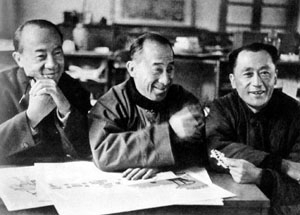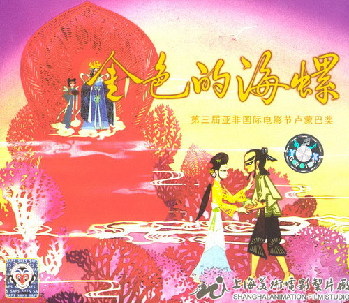| |
Chinese animated cartoon films enjoyed high reputations home and abroad. In the 1920s, the founders of the Chinese animated films, Wan Laiming, Wan Guchan and Wan Chaochen, the three brothers, strove arduously for the initiation and prosperity of animated films in the country. In 1941, they shot the first large-scale animated film in the country, the Princess Iron-Fan, which was a blockbuster in the country. It caused a sensation when shown in Southeast Asia and Japan.
After the liberation in 1949, Chinese animated films made substantial progress. In 1955, China shot the first color animated cartoon film Why the Crow Is Black, which won a prize at the 8th Venice International Preteen Film Exhibition in 1956. The puppet film Magic Painting Brush won the first prize at the 8th Venice International Preteen Film Exhibition in the group of literary films for children from 8 to 12 years old in 1956.

The founders of the Chinese animated films,
Wan Laiming, Wan Guchan and Wan Chaochen
It must be noted that Chinese fine art film industry workers introduced many new varieties to the garden of fine art films. In 1958, Wan Guchan creatively integrated shadow play and paper-cut art to produce a paper-cut film Pigsy Eats Watermelon, which bore distinct national features and was different from foreign black-and-white paper-cut films. In 1960, Yu Zheguang created paper folding films, a new variety in the country’s animated cartoon films, by applying manual paper folding as a modeling mode. The first paper folding film was The Wise Duck. At the end of 1960, Te Wei and Qian Jiajun completed the first ink and wash animated cartoon film, Where Is Mamma, which shifted the life-like images of frogs and tadpoles of Qi Baishi, a Chinese ink and wash drawing master, to the screens. It was a miracle in the history of animated cartoon films. It was an innovation in the world animated cartoon film sector. It became one of the Chinese animated cartoon films to win the largest number of prizes.
From 1956 to 1966, the Chinese animated film sector produced a lot of outstanding works, causing stirs in the world. They were represented by the animated cartoon film Monkey Makes Havoc in Heaven, ink-and-wash animated film The Cowherd's Flute, puppet film Princess Peacock, and paper-cut film Colorful Conch. They took part in international film activities, with 15 films winning 21 prizes, next only to Chinese feature movies.
II. Translate and dub foreign films
In order to enable Chinese audiences to better appreciate and understand foreign films, Northeast Film Studio decided to experiment in translating and dubbing foreign films, allowing the characters to speak Chinese on the screen. In mid May 1949, the studio completed dubbing the first feature movie, Rank and File. The script was translated by Meng Guangjun, Fu Ming (Xu Liqun) and Liu Chi. The leading actor and actress were dubbed by Zhang Yukun and Wu Jing respectively. This feature movie was about a story during the Soviet Union War of Defending the Country (1941~1945). In order to reduce casualties and eliminate the German invaders, soldier Matrosov sacrificed his own life to stop the enemy’s bullets with his own body. It was warmly welcomed by the Chinese audiences when it was shown across the country and in the army. It forcefully facilitated the victory of the Chinese people’s liberation war. In the spring of 1950, in order to rapidly end the monopoly of the Chinese film market by movies from the United States and Britain, Shanghai Film Studio dubbed a Soviet Union feature movie Son of the Regiment. It unveiled Shanghai’s efforts to dub foreign films.

In the first 17 years after the founding of New China, China imported and dubbed films from nearly 40 countries, compared with the original 10 countries. They comprised a lot of feature movies, newsreels, science and education films, and animated cartoon films.
The dubbed films were welcomed by the mass of audiences, with positive social effects.
In addition to dubbing excellent foreign films into films of Chinese dialogues, the Chinese Film Corporation cut in foreign language subtitles to Chinese films and dubbed some Chinese films in 16mm copies, so as to make foreign audiences better understand these Chinese films and facilitate exchanges with foreign countries. It dubbed four Chinese films, including The Red Detachment of Women, into Bambara, an African language, extending the influences of Chinese films in the world.
|
|
